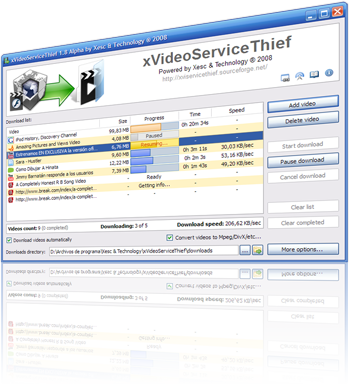Latest News
YouTube Updates Video Uploader, Increases Size Limit To 1GB
Sep 29th, 2008 | By James Lewin | Category: Internet TV, Video, Video Software  YouTube has announced an updated video uploader and bumped up the maximum file size for uploads.
YouTube has announced an updated video uploader and bumped up the maximum file size for uploads.
A random sample of YouTube users have already been using the beta version.
YouTube is opening up the streamlined uploader to everyone; just login to your YouTube account and click this link to opt in.
The new video upload tool includes these cool features:
- You can enter in your video’s metadata (title, description, tags, etc.) while the upload is processing.
- Upload multiple files at once, without downloading a plugin (separate progress bars will display for each file).
- The file-size limit for uploads has been raised from 100MB to 1GB.
The updates help keep YouTube competitive with other video sites.
Richard Stallman On Avoiding Ruinous Compromises
Sep 27th, 2008 | By James Lewin | Category: Commentary, GeneralTwenty-five years ago, Richard Stallman announced his plan to create a free operating system called GNU. Since then, Stallman’s work has had a massive influence on the world of free and open source software, software that powers much of the Internet.Â
In honor of the 25th anniversary of GNU, Stallman has penned an essay on Avoiding Ruinous Compromises
In it, Stallman looks at some of the compromises he’s had to make to move GNU forward, and how to judge which compromises are acceptable:
The free software movement aims for a social change: to make all software free so that all software users are free and can be part of a community of cooperation. Every non-free program gives its developer unjust power over the users. Our goal is to put an end to that injustice.
The road to freedom is a long road. It will take many steps and many years to reach a world in which it is normal for software users to have freedom. Some of these steps are hard, and require sacrifice. Some steps become easier if we make compromises with people that have different goals.
He pays special attention to what he calls ruinous compromises:
A ruinous compromise is not just a bad influence on others. It can change your own values, too, through cognitive dissonance. If you believe in certain values, but your actions imply other conflicting values, you are likely to change one or the other so as to resolve the contradiction. Thus, projects that argue only from practical advantages, or direct people towards some non-free software, nearly always shy away from even suggesting that non-free software is unethical. For their participants, as well as for the public, they reinforce consumer values. We must reject these compromises even to keep our values straight.
Sometimes Stallman comes across as an extreme fundamentalist – but this essay does a great job of exploring why he thinks it’s so vital to have high goals and to be uncompromising when you need to be.
It’s a great essay – and may leave you asking where you should be less compromising.
How’d You Like Your Internet Connection To Be 100 Times Faster?
Sep 27th, 2008 | By James Lewin | Category: General, Podcasting Research, Podcasting Statistics 
How’d you like your Internet speed to 100 times faster than it is today?
The Finnish government has announced plans for universal broadband access across Finland assuring that no person will be further than a mile and a half away from a broadband Internet connection of at least 100 megabits per second (Mbps).Â
“The development of that infrastructure is to be guaranteed in a way that all members of the public and companies, regardless of location, will have an opportunity to use information society services,” said Suvi Lindén, Finland’s communications minister.
The Finnish government set the 100 Mbps speed as a minimum, hoping to have gigabit-range speeds by 2015, understanding the economic and social importance of universal broadband as well as the need for governmental leadership in reaching that goal.Â
“Data connections are no longer entertainment but a necessity,” said Harri Pursiainen, the permanent secretary for the transport and communications minister. “Regional, equal communications infrastructure will not come about without state action.”Â
Research has shown that users with higher Internet connection speeds are more likely to spend time online and to use podcasts and Internet videos. Finland’s plans set a goal for the country to have Internet speeds that are about 100 times the speed of the average US connection.Â
via SpeedMatters
Image: Éole
Free, Open Source App Lets You Download Videos From YouTube & 50 Other Sites
Sep 27th, 2008 | By James Lewin | Category: Digital Video Downloads, General, Video   xVideoServiceThief (a.k.a xVST) is a free tool for downloading video clips from a variety of video websites.
xVideoServiceThief (a.k.a xVST) is a free tool for downloading video clips from a variety of video websites.
xVideoServiceThief also gives you the ability to convert each video into popular formats, including AVI, MPEG1, MPEG2, WMV, MP4, 3GP and MP3s.
Features:
- Cross-Platform: xVideoServicethief is available for the following platforms:
- Microsoft Windows Vista, Server 2003, XP, 2000, NT 4, Me/98
- Mac OS X, 10.3 and 10.4 coming
- Linux, Solaris, HP-UX, IRIX, AIX, many other Unix variants
- Simultaneous downloads: Download more than one video at same time
- Pause and resume your downloads (some servers do not support pause/resume functions, for example YouTube)
- Free!
- Automatic Updates
- Drag & Drop functions: Drag and Drop the video link directly to the xVideoServiceThief
- Multilanguage: Use xVideoService in your language
- Session Manager: Save and Restore your download lists
- Download Log: Save a list with all downloaded vide (Date + Title + URL)
- Accessible information: xVST has usable information for people with disabilities
- Children protection: Disable adult website support
- Customizable websites: Select which websites are allowed and which websites must be blocked
- Tray Icon functions: xVideoServiceThief can work in background mode
- Proxy server support: Is currently under beta version
- Bug Report: You can help to improve the future versions
- Open Source: The xVST is developed under the GNU General Public LicenseÂ
Blubrry Powerpress WordPress Plugin Updated
Sep 27th, 2008 | By James Lewin | Category: Podcasting Software  Blubrry has released another update to the Powerpress plugin for WordPress, version 0.3.0.
Blubrry has released another update to the Powerpress plugin for WordPress, version 0.3.0.
The latest version incorporates a number of new features and enhancements:
- Added list of important feeds in feed settings
- Logic to prevent stats redirect duplication
- Added podcast only feed
The new podcast only feed is useful if you wish to provide your audience a feed that only contains podcast episodes.
 The latest version may be downloaded here.
93 Percent Of Americans Believe Your Company Should Be Using Social Media
Sep 26th, 2008 | By James Lewin | Category: General  It’s time for corporate America to take a hard look at social media.
It’s time for corporate America to take a hard look at social media.
According to the a new survey:
- 93 percent of Americans believe a company should have a presence in social media;
- 85 percent believe a company should not only be present but also interact with its consumers via social media; and
- 56 percent of Americans feel both a stronger connection with and better served by companies when they can interact with them in a social media environment.
The stats come from the 2008 Cone Business in Social Media Study.
“The news here is that Americans are eager to deepen their brand relationships through social media,†explains Mike Hollywood, director of new media for Cone, “it isn’t an intrusion into their lives, but rather a welcome channel for discussion.â€
It’s clear from these numbers that it’s time for companies to get involved in social media. There’s no clear roadmap for this, so most companies are likely to proceed cautiously.
Online Video Audience Has Doubled In One Year
Sep 26th, 2008 | By James Lewin | Category: Featured Story, Podcasting Statistics  According to a new ABI Research survey, the number of people watching video streamed through a browser has doubled over the past year, going from 32% a year ago to 63% today.
According to a new ABI Research survey, the number of people watching video streamed through a browser has doubled over the past year, going from 32% a year ago to 63% today.
ABI attributes the trend to growth in the amount of rich content available in ad-supported format on portals and through social networks, as well as increasing demand from consumers for video in both short- and long-form online.
“Consumers are changing their online habits quickly,” says research director Michael Wolf. “Broadband speeds have continued to increase at the same time that Hollywood has decided online distribution is a legitimate monetization opportunity.”
All forms of content are contributing to the rise of broadband video consumption, including that of long-form TV shows, and much of the longer-form content today is being watched by younger viewers.
Other highlights:
- Nearly half of those under 25, and 53% of those aged 25-29, watch long-form content in the form of TV shows or movies online once a month or more;
- Older viewers are much more likely to have experimented once with online shows;
- Three quarters of those over 65 who watch video online responded that they have never watched TV shows or movies online.
“Today’s younger consumers are developing habits that will mean drastic changes for the video entertainment market,” said Wolf. “Many consume a large percentage or even a majority of their video entertainment through online distribution today, and we believe that this trend will continue to accelerate as more efforts are made to put this content on various non-PC screens.”
Image: tuexperto_com5
Twitter Election 2008 Site Powered By You
Sep 26th, 2008 | By James Lewin | Category: Citizen MediaTwitter has announced a new site, election.twiter.com, that tracks Twitter conversations of politics in real time.
During the first presidential debate in Oxford, Mississippi and each subsequent debate leading up to and beyond election day, Twitter plans to perform real-time algorithmic analysis on millions of unedited public reactions.Â
The site is addictive and it should be even more so during the debates.
Read more »
New Canon EOS 5D MKII Camera Brings State-Of-The-Art Digital Video To The Mainstream
Sep 25th, 2008 | By James Lewin | Category: Digital Video Recorder
Vincent Laforet filmed this short video that demonstrates the image quality of the Canon EOS 5D MKII.Â
The footage is amazing enough – but the fact that it was shot with a consumer DLSR is even more amazing. The camera can shoot about 8 minutes straight of higher than HD video.Â
The camera is expected to sell for about $2,700 (body), which puts it beyond the range of many, but also brings state-of-the-art digital video quality within the range of a lot of people.Â
Read more »
Google’s Vint Cerf On The Next Internet
Sep 25th, 2008 | By James Lewin | Category: Commentary, General  As part of Google’s 10th anniversary, the company asked ten of its experts for their take on the future of the Internet.Â
As part of Google’s 10th anniversary, the company asked ten of its experts for their take on the future of the Internet.Â
Today they posted “father of the Internet” Vint Cerf‘s take, and he keys in on two trends that we’ve focused on because of their importance to new media – mobile content creation and Internet video:
In the next decade, around 70% of the human population will have fixed or mobile access to the Internet at increasingly high speeds, up to gigabits per second. We can reliably expect that mobile devices will become a major component of the Internet, as will appliances and sensors of all kinds. Many of the things on the Internet, whether mobile or fixed, will know where they are, both geographically and logically. As you enter a hotel room, your mobile will be told its precise location including room number. When you turn your laptop on, it will learn this information as well–either from the mobile or from the room itself. It will be normal for devices, when activated, to discover what other devices are in the neighborhood, so your mobile will discover that it has a high resolution display available in what was once called a television set. If you wish, your mobile will remember where you have been and will keep track of RFID-labeled objects such as your briefcase, car keys and glasses. “Where are my glasses?” you will ask. “You were last within RFID reach of them while in the living room,” your mobile or laptop will say.
The Internet will transform the video medium as well. From its largely programmed, scheduled and streamed delivery today, video will become an interactive medium in which the choice of content and advertising will be under consumer control. Product placement will become an opportunity for viewers to click on items of interest in the field of view to learn more about them including but not limited to commercial information. Hyperlinks will associate the racing scene in Star Wars I with the chariot race in Ben Hur. Conventional videoconferencing will be augmented by remotely controlled robots with an ability to move around, focus cameras and microphones, and perhaps even directly interact with the local environment under user control.
Cerf’s right.
When you look at today’s iPhone, remember that ten years ago, the iMac was hot stuff, with a 233 Mhz processor, 32 MB Ram and a 4 GB hard drive.
Extrapolate that sort of change forward, and in ten years you’re likely to have a phone with 800 GB of flash memory, a 4 Ghz multiprocessing CPU and broadband connectivity.Â
That sort of shift in mobile power will massively change what is possible with mobile devices, and one the most important changes will be that mobile video publishing will become mainstream.Â
See the Google blog for Cerf’s full article.
